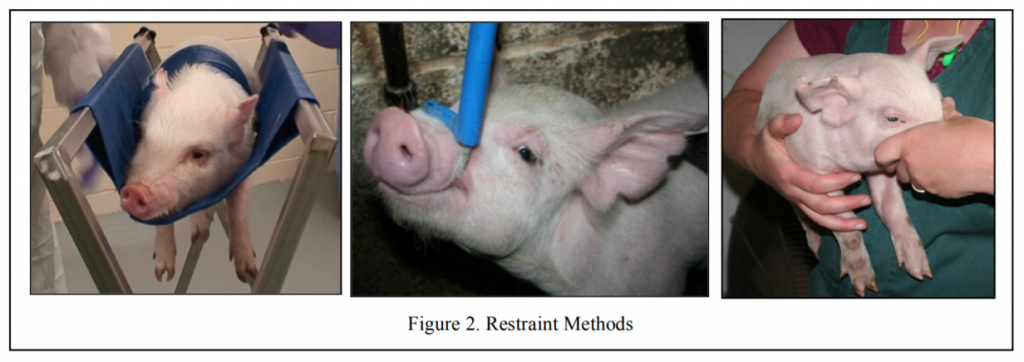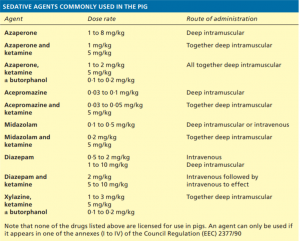Food Animal Drugs
Swine Analgesia, Sedation and Anesthesia
Pigs are pigs. Since swine are a “major” species in the food animal world, all swine rules and regulations need to be followed, even in pet pigs.
NSAIDS
Flunixin meglumine is the only approved NSAID. Meloxicam is used off label due to its better analgesic properties.
- Meloxicam 0.4mg/kg PO q 24 hours – better oral bioavailability than oral flunixin
- Flunixin meglumine 1.1-2.2mg/kg IM once (don’t often do more than once due to pig temperament and concern for muscle damage)
Other Analgesics
Transdermal fentanyl (small pigs) patches dosed at 3 ucg/kg/hr resulted in serum concentrations that were above the reported efficacy ranges in people.
Epidurals -The site for needle placement is on the midline and caudal to a transverse line between the cranial prominences of the wing of the ilium (iliac crest) on either side, 0.5 to 1.5 cm in pigs weighing 10 to 50 kg and 1.5 to 2.5 cm in pigs weighing 50 kg or more. A vertical line through the patella may be used as a guide to locate the lumbosacral space 2.5 cm caudal to the vertical line in large pigs in which the iliac wings are not palpable.
Sedatives and anesthesia
Pigs do not like being handled and create quite a lot of noise. The noise disturbs everyone around them. If you can work on the pig while the owner holds them, that might help your eardrums. Most pigs are heavily sedated for procedures. One exception is “forking “- it really works to calm them and has a slight residual. It is useful for injections, temperature taking, listening to hearts, etc.
Other restraint methods

Demo video from a pig hoof trimmer of how she restrains without sedation
Injections into fatty tissue have delayed drug absorption. Use long needles (3cm) and inject behind the ears.
Xylazine doesn’t work well in pigs. Pigs are very insensitive to xylazine and they tend to vomit. It is used but is not a great drug in pigs. Benzodiazepines and butorphanol combos are better.
Sedation protocols used in the UMN VMC
- 4mg/kg ketamine IM + 0.4 mg/kg Diazepam IV or Midazolam IM
- excited pigs may need other drugs or inhalant
- may have dysphoria during recovery phase
- 0.2mg/kg Butorphanol IM + 0.2mg/kg Midazolam IM
- good for induction prior to inhalant
- allow 10 minutes for full effect
- may cause nausea and vomiting, especially during recovery phase
- Piggy Magic – 0.2 mg/kg butorphanol + 0.2 mg/kg midazolam + 2-6 mg/kg ketamine combined and given im {typically use higher end of ketamine dose}. Piggy Magic provides a decent plane of sedation for minor procedures and lasts 30-45 minutes.
- Intranasal midazolam can be used for calming (0.2-0.5 mg/kg). Use a 22g catheter to splash the nasal cavity. Allow 10-15 minutes to take effect.
- Dexmedetomidine (5-10 ug/kg im) can provide sufficient sedation for an examination
- reversal with tolazoline improves things – 2 mg/kg im
- Newer protocols with tolazoline given at 45 min
- TZDB (tiletamine-zolazepam [3 mg/kg], detomidine [0.18 mg/kg ], and butorphanol [0.12 mg/kg]
- TZXB (tiletamine-zolazepam [4 mg/kg], xylazine [4 mg/kg], and butorphanol [0.2 mg/kg]
- KDB (ketamine [8 mg/kg], detomidine [0.18 mg/kg], and butorphanol [0.3 mg/kg])
- From Comparison of anesthetic and cardiorespiratory effects of tiletamine-zolazepam-detomidine-butorphanol,
tiletamine-zolazepam-xylazine-butorphanol, and ketamine-detomidine-butorphanol in pigs. JAVMA | APR 15, 2021 | VOL 258 | NO. 8. Pp 883-891
- From Comparison of anesthetic and cardiorespiratory effects of tiletamine-zolazepam-detomidine-butorphanol,
Pig can be intubated
- wait to extubate until pig is almost chewing tube
Pig cannot be intubated
- Naloxone 0.02 mg/kg iv for opioids
- Flumazenil 0.02-0.4 mg/kg iv for benzodiazepenes
- Tolazoline – 1/2 im and 1/2 iv or all im for alpha-2 agents
- Atipamezole (0.16mg/kg) im for alpha-2 agents
Resources
Review of venipuncture and intravenous catheterization techniques in pigs- JAVMA. 262. 1-9. 10.2460/javma.24.03.0169. Nice explanation of options with great pictures
Miniature Companion Pig Sedation and Anesthesia, JS Smith, VCNA/Exotics, 2022- lots of good hints about handling, restraint and drugs
Guidelines on Anesthesia and Analgesia in Swine, UMI, 2018
Practical sedation and anaesthesia of pigs, In practice, 2007

Overview of Malignant Hyperthermia, Merck
Anesthesia agents and complications in Vietnamese potbellied pigs, JAVMA 01 July 2011, Vol.239(1), pp.114-21
Objective—To document complications associated with preanesthetic and anesthetic agents used in Vietnamese potbellied pigs and identify predictors of complications.
Design—Retrospective case series.
Animals—27 potbellied pigs (14 female and 13 male) ranging in age from 0.25 to 15 years old and ranging in body weight from 5.9 to 169 kg (13.0 to 371.8 lb) that were anesthetized on 32 occasions between 1999 and 2006.
Procedures—Data, including perianesthetic management, anesthetic agents and dosages, complications, and outcome, were retrieved from medical records. Patient information, anesthetic agents, and duration of anesthesia were evaluated as predictors for development of complications.
Results—Anesthesia was maintained with isoflurane or sevoflurane during 30 anesthetic episodes. Commonly used premedicants were butorphanol, atropine, and midazolam administered in combination with xylazine or medetomidine and a combination of tiletamine-zolazepam and butorphanol. Anesthesia was induced with an inhalation agent on 15 occasions, via injection of ketamine on 10 occasions, and via injection of propofol on 3 occasions. Complications included hypoventilation (16/24 [67%]), hypotension (16/25 [64%]), hypothermia (15/31 [48%]), bradycardia (9/32 [28%]), and prolonged recovery time (7/32 [22%]). None of the factors evaluated were associated with development of these complications. All pigs survived anesthesia.
Conclusions and Clinical Relevance—Results suggested that a variety of anesthetic agent combinations can be used to provide anesthesia in potbellied pigs with satisfactory outcomes. Although there were high incidences of hypoventilation, hypotension, and hypothermia, no specific anesthetic agent was associated with development of these complications.

